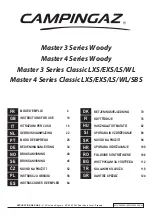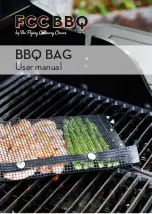
GB
NOTE: Unless otherwise specified, following generic terms “appliance / unit / product / equipment / device” appeared in this
instruction manual all refer to the product “Master Series”.
The product shown in this manual may look different from yours. It is for illustration purpose only.
y
Please read the instructions carefully before use.
y
Use outdoors only.
y
Do not use charcoal.
y
Do not use an adjustable low pressure regulator. Only use fixed regulators that comply with relevant European
Standards.
y
To ensure safe operation of your device, never use two full griddles side by side.
y
Regularly clean the parts at the frame bottom to avoid risk of inflammation from fat drippings.
Follow these instructions carefully to avoid serious damage to your barbecue.
INSTRUCTIONS FOR USE
A. FOR YOUR SAFETY
y
Do not store or use petrol and other flammable liquids or
vapours in the vicinity of this appliance. This device must
be kept away from inflammable materials when it is in use.
If you smell gas:
1.
Close the valve of the cylinder.
2.
Extinguish all naked flames.
3.
Open the lid.
4.
If the smell continues, see “
F. Checking for gas leaks
” or
immediately seek advice from your local retailer.
y
Do not leave your appliance unattended while it is working.
y
Parts which are protected by the manufacturer or the
manufacturer’s representative must not be manipulated by
the user.
y
Close the gas container after use.
B. LOCATION
y
This appliance must only be used outdoors.
y
CAUTION
: accessible parts may get very hot. Keep young
children away.
y
There should be no combustible materials within a radius of
approximately 60 cm around the appliance.
y
Do not move the appliance when alight.
y
The appliance should be operated on a level surface.
y
Estimated air offtake is 2 m
3
/kW/h.
C. GAS CYLINDER
This appliance has been adjusted to operate from 4.5 to 15
kg butane/propane cylinders with an appropriate low pressure
regulator:
y
France, Belgium, Luxembourg, United Kingdom, Ireland,
Portugal, Spain, Italy, Greece:
butane 28 mbar / propane 37 mbar.
y
Netherlands, Czech Republic, Slovakia, Hungary,
Switzerland, Slovenia, Norway, Sweden, Denmark,
Finland, , Bulgaria, Turkey, Romania, Croatia:
butane 30 mbar / propane 30 mbar.
y
Poland:
propane 37 mbar.
Always connect or replace the cylinder in a well-ventilated
area, never in the presence of a flame, spark or heat source.
The possibility of putting the gas cylinder under the appliance
depends on the model used and the height of the cylinder.
See assembly manual.
D. HOSE (FIG. 1)
The appliance should be used with flexible hose that is suitable
for use with butane and propane gas. Hose length should not
exceed 1.50 metre. It should be replaced if it is damaged or
cracked, when required by national regulations or at the end
of its lifecycle.
France (depending on model):
Flexible hose designed to be joined onto ringed tail pieces on
both the appliance and regulator sides, held firm with collars
(in accordance with standard XPD 36-110). Recommended
length 1.25 m.
1.
Connect the flexible hose to the connector and secure the
connection with a clamping collar (Fig 2).
2.
Connect the other end of the hose to your regulator and
secure the connection with a clamping collar (Fig 2).
3.
Connect the regulator to your cylinder (Fig 2).
4.
Check for leaks following the instructions in section F.
Do not pull or pierce the hose. Keep away from any parts of the
appliance that get hot (see Fig. 3-B and 3-C). Check that the
flexible hose stretches out normally, without twisting or pulling.
E. LID
Handle the lid carefully, especially during operation. Do not
lean over the base.
F. CHECKING FOR GAS LEAKS
Important:
never use a naked flame to check for gas leaks.
1.
Work outside, away from all sources of ignition. Do not
smoke.
2.
Make sure the control knobs are in the “off” (O) position.
3.
Fit the regulator onto the gas cylinder in accordance with
its instructions.
4.
Connect the flexible hose to the regulator and appliance as
described in section
§ D
.
5.
Use a gas leak solution to test for leaks.
6.
(Depending on the model, see Fig. 5-A or 5-B, and Fig. 3-A)
Apply the solution to the connections between cylinder/
regulator/ hose / appliance.
7.
Open the gas cylinder valve (the control knobs should
remain closed: off position (O)). Bubbles in the gas leak
solution indicate that there is a gas leak.
8.
The leak can be stopped by tightening any hose connection
or replacing any faulty component. The appliance must not
be used until the leak is stopped.
9.
Close the valve on the gas cylinder.
Important:
Check for leaks at least once per year and each time the gas
cylinder is replaced.
10











































